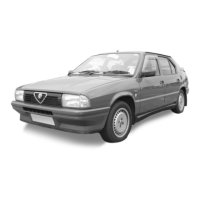Do you have a question about the Alfa Romeo 4C 2017 and is the answer not in the manual?
Explains how to navigate and utilize the manual for information.
Highlights crucial safety alerts and operational cautions.
Details the location and importance of the VIN.
Explains various vehicle and manual symbols.
Information about vehicle keys and their functions.
Details on the Sentry Key immobilizer system.
Explains the vehicle's security alarm system.
Operation of the remote keyless entry system.
How to lock and unlock vehicle doors.
Details on airbags, seat belts, and child restraints.
Guidelines for the initial break-in period of the vehicle.
Provides general safety advice for vehicle operation.
Steps for removing the ignition key.
Alert for key left in ignition.
How to lock doors using the physical key.
Information on obtaining replacement keys.
Information on power windows and their operation.
Instructions for opening and closing the vehicle's decklid.
Protects knees during frontal impact.
Details side airbag system for occupant protection.
System that responds to accidents by cutting fuel, flashing lights, etc.
Records vehicle data during crashes or near-crashes.
Guidelines for safely transporting pets in the vehicle.
Rules and safety for carrying passengers.
Routine checks for inside the vehicle.
Operation of the vehicle's defroster system.
Crucial safety information regarding floor mats.
Recommendations for external vehicle safety checks.
Information on interior and exterior mirrors.
Details on seat adjustment and features.
Information on headlights, turn signals, and other lights.
Operation of wipers and washers.
How to adjust the steering column position.
Operation and features of the cruise control system.
Information on the vehicle's parking sensor system.
Usage of the vehicle's power outlets.
Information on the cigar lighter and ash receiver.
Information on vehicle storage compartments.
Details on the vehicle's non-adjustable head restraints.
Overview of instrument panel components.
Details on the vehicle's instrument cluster layout and gauges.
Explains various warning and indicator lights.
Information on the digital display features.
Explains the driving mode selection system.
Explains the meaning of red warning lights.
Indicates low engine oil pressure.
Signals a problem with the electronic throttle system.
Alerts to potential issues with the airbag system.
Notifies when seat belts are unbuckled.
Monitors and warns about tire pressure levels.
Indicates various system faults or requests.
Alerts to issues with the ABS system.
Indicates when the ESC system is deactivated.
Indicates when the ESC system is active or has issues.
Warns about engine or emission control system issues.
Signals when scheduled vehicle maintenance is due.
Indicates when front fog lights are activated.
Indicates when the door mirror defroster is active.
Shows when cruise control is active but not set.
Indicates when high beam headlights are on.
Controls for navigating and adjusting the instrument cluster display.
Options for customizing the instrument cluster display settings.
Allows setting a speed limit alert.
Option to activate or deactivate the Trip B display.
Procedure for setting the vehicle's clock.
Procedure for setting the current date.
Automatic door locking feature at specific speeds.
Setting measurement units for distance, temp, and fuel.
Options for changing the display language.
Adjusting the volume of system alerts.
Information on scheduled maintenance intervals.
Information on vehicle's cybersecurity features and risks.
Components and overview of the vehicle's radio system.
Overview of the climate control system and its functions.
Recommendations for maintaining the climate control system.
Steps for properly starting the vehicle.
Operation of the automatic transmission.
Procedure for normal engine starting.
Guidelines for starting the vehicle in cold temperatures.
Troubleshooting steps when the engine won't start.
Procedure to cool down the turbocharger after driving.
Information on the vehicle's twin-clutch transmission system.
Instructions for properly parking the vehicle.
System for selecting driving modes (Dynamic, Natural, All Weather, Race).
High-performance acceleration strategy for off-road use.
Advice for driving in low-traction conditions.
Precautions for driving in shallow or flowing water.
Information on the vehicle's dual hydraulic brake systems.
Distributes brake force for stability.
Aids vehicle control during adverse braking.
Optimizes brake pressure distribution on corners.
Prevents excessive drag during downshifts or braking.
Manages wheel slip to enhance traction.
Facilitates starting on slopes.
Enhances braking capacity during emergency braking.
Information on tire markings and safety.
Definitions of common tire terms.
Details on tire load capacity and information placard location.
General information about vehicle tires and their importance.
Guidelines for using radial ply tires.
Criteria for repairing damaged tires.
Information on different types of tires (All Season, Summer).
Guidelines for using snow tires in winter conditions.
Information and limitations of run-flat tires.
Guidance on matching spare tires to original equipment.
Information and warnings about compact spare tires.
Information and warnings about collapsible spare tires.
Information and warnings about full-size spare tires.
Information and warnings for limited-use spare tires.
Advice on avoiding wheel spin in slippery conditions.
Factors affecting a tire's service life.
Guidelines for selecting and replacing tires.
Recommendations and precautions for using tire chains.
Guidance on tire rotation for even wear.
Explains DOT tire grading standards.
Explanation of the treadwear rating.
Explanation of tire traction grades.
Explanation of tire temperature grades.
How the TPMS works and its warnings.
Details on the correct type of fuel for the 1750 Turbo engine.
Important precautions for maintaining the fuel system.
Safety warnings regarding carbon monoxide exposure.
Procedure for adding fuel and information on Smart Fuel.
Information regarding trailer towing recommendations.
Guidelines for towing the vehicle behind another vehicle.
How to activate hazard warning flashers in an emergency.
Steps to take if the engine overheats.
Specifications for wheel lug nut/bolt torque.
Information on using the tire service kit for punctures.
Procedures for jump-starting the vehicle's battery.
How to use the front tow eye for towing.
Location and use of the fire extinguisher.
Functionality of the EARS system.
Records vehicle data during crashes or near-crashes.
Specific torque values for wheel lug nuts/bolts.
Step-by-step guide for jump-starting the vehicle.
How to install and use the front tow eye for towing.
Location and use of the fire extinguisher.
Functionality of the EARS system.
Records vehicle data during crashes or near-crashes.
Location of key components in the engine compartment.
Information on the OBD II system and its function.
Requirements for vehicle emissions testing.
Guidance on using genuine replacement parts.
Importance and benefits of authorized dealer service.
Detailed steps for routine vehicle maintenance.
Information on vehicle fuses and their locations.
Steps for protecting the vehicle during long-term storage.
Information on checking and maintaining engine oil levels.
Procedure for replacing the engine oil filter.
Information on maintaining the engine air cleaner filter.
Instructions for removing and reinstalling the engine cover.
Information about the vehicle's maintenance-free battery.
Service and checks for the air conditioning system.
Periodic lubrication points for body components.
Instructions for cleaning and maintaining wiper blades.
Information on adjusting and maintaining washer nozzles.
Procedure for checking and refilling windshield washer fluid.
Inspection and maintenance of the exhaust system.
Information on checking, draining, and refilling the cooling system.
Guidance on checking and maintaining the brake master cylinder fluid level.
How to protect the vehicle's body and paint from corrosion.
Guidelines for cleaning and maintaining wheels and trim.
Instructions for cleaning stain-repel fabric seats.
Recommendations for cleaning interior upholstery and surfaces.
Instructions for cleaning the vehicle's headlights.
How to clean interior and exterior glass surfaces.
Cleaning the instrument panel cover and bezels.
Procedures for maintaining seat belts.
Information on vehicle fuses and replacement.
Steps for protecting the vehicle during long-term storage.
Information on replacing various vehicle bulbs.
Procedure for replacing the front side marker bulb.
Information on replacing tail light and brake light bulbs.
Procedure for replacing the reversing light bulb.
Information on replacing the third brake light bulb.
Procedure for replacing license plate bulbs.
Procedure for replacing the interior roof light bulb.
Procedure for replacing the luggage compartment light bulb.
Table of fluid capacities for various vehicle systems.
Recommendations for engine fluids, lubricants, and parts.
Information on chassis fluids and lubricants.
Overview of scheduled maintenance services.
Detailed schedule of required maintenance tasks.
Procedure for replacing drive belts.
Procedure for replacing spark plugs.
Procedure for replacing the timing belt.
Steps for changing engine oil and filter.
Interval for changing brake fluid.
Procedure for replacing the air filter cartridge.
Tips for getting service for your vehicle.
How to get help from the manufacturer or dealer.
Information about the vehicle's warranty coverage.
How to report vehicle safety defects to authorities.
How to order additional manuals or publications.
Information on how to obtain owner's manuals.
Explains how to navigate and utilize the manual for information.
Highlights crucial safety alerts and operational cautions.
Details the location and importance of the VIN.
Explains various vehicle and manual symbols.
Information about vehicle keys and their functions.
Details on the Sentry Key immobilizer system.
Explains the vehicle's security alarm system.
Operation of the remote keyless entry system.
How to lock and unlock vehicle doors.
Details on airbags, seat belts, and child restraints.
Guidelines for the initial break-in period of the vehicle.
Provides general safety advice for vehicle operation.
Steps for removing the ignition key.
Alert for key left in ignition.
How to lock doors using the physical key.
Information on obtaining replacement keys.
Information on power windows and their operation.
Instructions for opening and closing the vehicle's decklid.
Protects knees during frontal impact.
Details side airbag system for occupant protection.
System that responds to accidents by cutting fuel, flashing lights, etc.
Records vehicle data during crashes or near-crashes.
Guidelines for safely transporting pets in the vehicle.
Rules and safety for carrying passengers.
Routine checks for inside the vehicle.
Operation of the vehicle's defroster system.
Crucial safety information regarding floor mats.
Recommendations for external vehicle safety checks.
Information on interior and exterior mirrors.
Details on seat adjustment and features.
Information on headlights, turn signals, and other lights.
Operation of wipers and washers.
How to adjust the steering column position.
Operation and features of the cruise control system.
Information on the vehicle's parking sensor system.
Usage of the vehicle's power outlets.
Information on the cigar lighter and ash receiver.
Information on vehicle storage compartments.
Details on the vehicle's non-adjustable head restraints.
Overview of instrument panel components.
Details on the vehicle's instrument cluster layout and gauges.
Explains various warning and indicator lights.
Information on the digital display features.
Explains the driving mode selection system.
Explains the meaning of red warning lights.
Indicates low engine oil pressure.
Signals a problem with the electronic throttle system.
Alerts to potential issues with the airbag system.
Notifies when seat belts are unbuckled.
Monitors and warns about tire pressure levels.
Indicates various system faults or requests.
Alerts to issues with the ABS system.
Indicates when the ESC system is deactivated.
Indicates when the ESC system is active or has issues.
Warns about engine or emission control system issues.
Signals when scheduled vehicle maintenance is due.
Indicates when front fog lights are activated.
Indicates when the door mirror defroster is active.
Shows when cruise control is active but not set.
Indicates when high beam headlights are on.
Controls for navigating and adjusting the instrument cluster display.
Options for customizing the instrument cluster display settings.
Allows setting a speed limit alert.
Option to activate or deactivate the Trip B display.
Procedure for setting the vehicle's clock.
Procedure for setting the current date.
Automatic door locking feature at specific speeds.
Setting measurement units for distance, temp, and fuel.
Options for changing the display language.
Adjusting the volume of system alerts.
Information on scheduled maintenance intervals.
Information on vehicle's cybersecurity features and risks.
Components and overview of the vehicle's radio system.
Overview of the climate control system and its functions.
Recommendations for maintaining the climate control system.
Steps for properly starting the vehicle.
Operation of the automatic transmission.
Procedure for normal engine starting.
Guidelines for starting the vehicle in cold temperatures.
Troubleshooting steps when the engine won't start.
Procedure to cool down the turbocharger after driving.
Information on the vehicle's twin-clutch transmission system.
Instructions for properly parking the vehicle.
System for selecting driving modes (Dynamic, Natural, All Weather, Race).
High-performance acceleration strategy for off-road use.
Advice for driving in low-traction conditions.
Precautions for driving in shallow or flowing water.
Information on the vehicle's dual hydraulic brake systems.
Distributes brake force for stability.
Aids vehicle control during adverse braking.
Optimizes brake pressure distribution on corners.
Prevents excessive drag during downshifts or braking.
Manages wheel slip to enhance traction.
Facilitates starting on slopes.
Enhances braking capacity during emergency braking.
Information on tire markings and safety.
Definitions of common tire terms.
Details on tire load capacity and information placard location.
General information about vehicle tires and their importance.
Guidelines for using radial ply tires.
Criteria for repairing damaged tires.
Information on different types of tires (All Season, Summer).
Guidelines for using snow tires in winter conditions.
Information and limitations of run-flat tires.
Guidance on matching spare tires to original equipment.
Information and warnings about compact spare tires.
Information and warnings about collapsible spare tires.
Information and warnings about full-size spare tires.
Information and warnings for limited-use spare tires.
Advice on avoiding wheel spin in slippery conditions.
Factors affecting a tire's service life.
Guidelines for selecting and replacing tires.
Recommendations and precautions for using tire chains.
Guidance on tire rotation for even wear.
Explains DOT tire grading standards.
Explanation of the treadwear rating.
Explanation of tire traction grades.
Explanation of tire temperature grades.
How the TPMS works and its warnings.
Details on the correct type of fuel for the 1750 Turbo engine.
Important precautions for maintaining the fuel system.
Safety warnings regarding carbon monoxide exposure.
Procedure for adding fuel and information on Smart Fuel.
Information regarding trailer towing recommendations.
Guidelines for towing the vehicle behind another vehicle.
How to activate hazard warning flashers in an emergency.
Steps to take if the engine overheats.
Specifications for wheel lug nut/bolt torque.
Information on using the tire service kit for punctures.
Procedures for jump-starting the vehicle's battery.
How to use the front tow eye for towing.
Location and use of the fire extinguisher.
Functionality of the EARS system.
Records vehicle data during crashes or near-crashes.
Specific torque values for wheel lug nuts/bolts.
Step-by-step guide for jump-starting the vehicle.
How to install and use the front tow eye for towing.
Location and use of the fire extinguisher.
Functionality of the EARS system.
Records vehicle data during crashes or near-crashes.
Location of key components in the engine compartment.
Information on the OBD II system and its function.
Requirements for vehicle emissions testing.
Guidance on using genuine replacement parts.
Importance and benefits of authorized dealer service.
Detailed steps for routine vehicle maintenance.
Information on vehicle fuses and their locations.
Steps for protecting the vehicle during long-term storage.
Information on checking and maintaining engine oil levels.
Procedure for replacing the engine oil filter.
Information on maintaining the engine air cleaner filter.
Instructions for removing and reinstalling the engine cover.
Information about the vehicle's maintenance-free battery.
Service and checks for the air conditioning system.
Periodic lubrication points for body components.
Instructions for cleaning and maintaining wiper blades.
Information on adjusting and maintaining washer nozzles.
Procedure for checking and refilling windshield washer fluid.
Inspection and maintenance of the exhaust system.
Information on checking, draining, and refilling the cooling system.
Guidance on checking and maintaining the brake master cylinder fluid level.
How to protect the vehicle's body and paint from corrosion.
Guidelines for cleaning and maintaining wheels and trim.
Instructions for cleaning stain-repel fabric seats.
Recommendations for cleaning interior upholstery and surfaces.
Instructions for cleaning the vehicle's headlights.
How to clean interior and exterior glass surfaces.
Cleaning the instrument panel cover and bezels.
Procedures for maintaining seat belts.
Information on vehicle fuses and replacement.
Steps for protecting the vehicle during long-term storage.
Information on replacing various vehicle bulbs.
Procedure for replacing the front side marker bulb.
Information on replacing tail light and brake light bulbs.
Procedure for replacing the reversing light bulb.
Information on replacing the third brake light bulb.
Procedure for replacing license plate bulbs.
Procedure for replacing the interior roof light bulb.
Procedure for replacing the luggage compartment light bulb.
Table of fluid capacities for various vehicle systems.
Recommendations for engine fluids, lubricants, and parts.
Information on chassis fluids and lubricants.
Overview of scheduled maintenance services.
Detailed schedule of required maintenance tasks.
Procedure for replacing drive belts.
Procedure for replacing spark plugs.
Procedure for replacing the timing belt.
Steps for changing engine oil and filter.
Interval for changing brake fluid.
Procedure for replacing the air filter cartridge.
Tips for getting service for your vehicle.
How to get help from the manufacturer or dealer.
Information about the vehicle's warranty coverage.
How to report vehicle safety defects to authorities.
How to order additional manuals or publications.
Information on how to obtain owner's manuals.
| Brand | Alfa Romeo |
|---|---|
| Model | 4C 2017 |
| Category | Automobile |
| Language | English |











